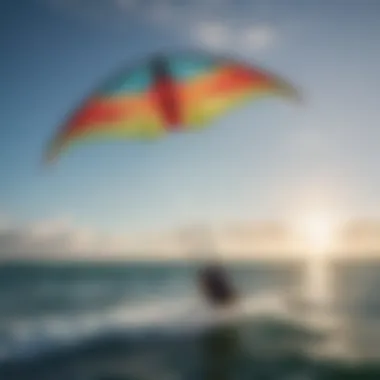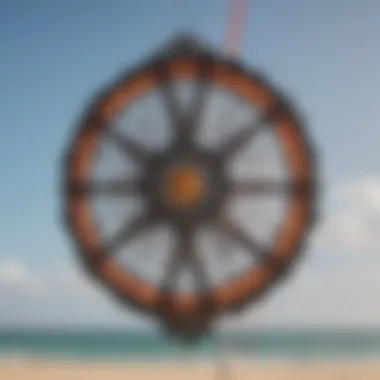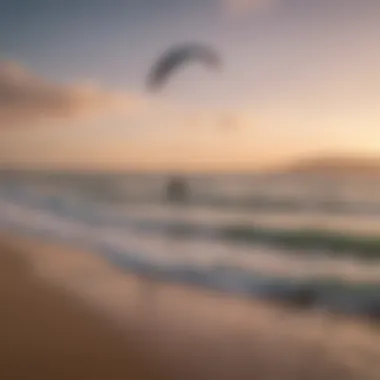Ultimate Guide to Kitesurfing Training Kites for All Levels


Intro
Kitesurfing is an exhilarating sport that combines wind, water, and skill. Training kites play a pivotal role in mastering this activity. They cater to learners and seasoned kiitesurfers, serving as essential tools for skill development. Understanding what makes a training kite effective, along with key elements such as safety standards and equipment selection, significantly enhances kitesurfer proficiency.
In this guide, we examine the multifaceted aspects of kitesurfing training kites. We discuss equipment categories, safety protocols, and techniques vital for both novice and advanced riders. By dissecting these components, our goal is to equip readers with valuable insights on how to optimize their kitesurfing experience.
Equipment Reviews
A comprehensive analysis of kitesurfing equipment is essential for choosing the right training kite, appropriate boards, and necessary accessories. Understanding these elements is crucial for elevating kitesurfing practices.
Kites
When considering training kites, familiarity with key kite models is paramount. Moderrn training kites provide enhanced stability and control in diverse conditions. Popular models such as the Duotone Neo and North Pulse boast advanced features for learners. Here are some key kite categories:
- Kite Shapes: C-shaped and hybrid kites both serve different skill levels. C-shapes offer agility, while hybrid kites strike a balance.
- Kite Sizes: The measurements can range from 3m to 17m, with smaller kites suited for stronger winds and larger kites designed for lighter conditions.
- Materials: Look for durable fabrics that resist stretching and damage, ensuring longevity and performance.
- Key Brands: Eleveight, Cabrinha, and Liquid Force are worth exploring. They provide solid options that meet various skill sets and conditions.
Boards
Understanding the differences between types of boards will aid in making an informed decision. Two common categories are directional boards and twintips.
- Directional Boards: Ideal for wave riding, these boards move in a specific direction and often provide asurfing experience. They encompass unique designs that cater to riding styles.
- Twintips: A versatile option, twintips can be ridden in either direction, making them popular among beginners. Their design generally supports flat water performance and jumps.
Accessories
Proper accessories are fundamental for a successful kitesurfing experience. Consider the following essentials:
- Harnesses: Select a harness fitting your needs. Waist harnesses are common in the regular environment. Seat harnesses provide additional support for beginners.
- Lines and Pumps: High-quality lines improve performance and safety. Pumps streamline the inflation process and affect kite responsiveness.
- Safety Gear: A personal flotation device, a helmet, and a knife are critical for handling unforeseen crises on the water. Regular checks contribute to safer outings.
End
This guide underscores the multifarious dimensions of kitesurfing training kites, the equipment they require, and associated features explaining the learning process. Becoming proficient in kitesurfing entails investing time and effort into mastering these elements. As we continue into the subsequent sections, we will delve deeper into travel destinations, techniques, and safety guidelines that further contribute to embracing the kitesurfing journey. Every thoughtful decision you make can amplify your skills, ensuring an enjoyable experience on the water.
Preface to Kitesurfing Training Kites
Kitesurfing is a thrilling sport that demands precision and control. At the heart of the learning process lies the kitesurfing training kite. The use of training kites provides an accessible entry point for beginners while offering experienced riders the tools to refine their techniques. Understanding kitesurfing training kites is crucial for facilitating progression, developing a robust skill set, and ensuring safety on the water.
In examining kitesurfing training kites, we uncover various features and designs tailored for enhancing the learning experience. These kites serve multiple functions, from providing essential flight control to aiding in wind awareness. For anyone looking to advance in kitesurfing, comprehending their advantages, specifications and implementation is paramount.
Definition and Purpose
A kitesurfing training kite is designed specifically for instructional purposes. It helps users grasp kite control fundamentals in a safe environment, usually inland or on calmer waters. The size, shape, and construction differences of training kites are optimized for rigors of education and skill development.
These kites serve several important purposes.
- Skill Development: Novices can improve their control over the kite, increasing confidence before taking on larger, more powerful kites.
- Wind Awareness: Riders learn to read wind conditions, essential for kitesurfing in open waters.
- Control System Familiarization: Training kites often feature control systems that parallel those of larger kites, providing realistic practice.
Utilizing a training kite equips users with a strong foundation, which is vital before moving on to more complex maneuvers and equipment adjustments.
The Evolution of Kitesurfing
Kitesurfing, as a modern sport, has its roots in various historical kite flying methods. The late 20th century witnessed the emergence of kitesurfing as a recreational activity, leading to the development of specialized training kites.
Initially, these kites were simple structures often crafted from basic materials and rudimentary designs. As interest in the sport grew, manufacturers advanced the quality, focusing on design efficiency and pilot safety. This evolution spans numerous turns of innovation, such as:
- Material Enhancements: The introduction of lightweight, robust materials improved durability and performance.
- Improved Control Mechanics: Developing sophisticated control systems has made kites more responsive to user inputs, paving the way for better training results.
- Custom Designs and Sizes: Modern kites come in various sizes and shapes, mapping out multiple uses based on specific rider goals and local conditions.
By focusing on specific elements that cater to skill acquisition and educational development, the evolution of kitesurfing training kites has significantly influenced the sport’s growing popularity.
Types of Training Kites
Understanding the various types of kites is essential for anyone aiming to master kitesurfing. Each type offers unique benefits, aligning with different skill levels, personal preferences, and environmental conditions. Knowing these elements makes the learning process smoother and more effective. Here, we outline three major types of training kites, providing details on their characteristics and advantages.
Foil Kites
Foil kites are recognized by their soft structure, which comprises numerous internal cells that trap air. This design allows for efficient lifting capabilities. Foil kites are renowned for their responsiveness and stability. Dwonwind performance also stands out, as they maintain power in lower winds.
The following are notable features of foil kites:


- Lightweight: Their minimal weight contributes to better control, especially during maneuvers.
- Packability: Easy to fold, they take up less space, making them ideal for traveling.
- Wind Range: They perform well across a range of wind conditions, making them adaptable to different surfing environments.
However, they may lack some performance in extreme high-wind situations compared to inflatable kites.
Leading Edge Inflatable Kites
Leading edge inflatable kites, widely regarded as the most popular choice for beginners, come adorned with an inflatable leading edge that allows for easy relaunching. This aspect makes them exceptionally user-friendly. These kites are known for their stability during flight and their ability to handle turbulent wind well.
Key attributes of leading edge inflatable kites include:
- Relaunchable Design: Should the kite fall, getting it back into the air is relatively effortless, especially for novices.
- Durability: The materials used in construction contribute to their robustness, ensuring longevity—a critical aspect for those beginning their kitesurfing journey.
- Power Generation: They offer substantial lift, delivering power effectively, particularly in moderate to strong winds.
Despite their advantages, they can be cumbersome for advanced riders looking for speed and agility if weighed down by less efficient designs.
Single Skin Kites
Single skin kites have gained popularity as a lightweight and streamlined option. Their simplicity lays in having only one layer of fabric, with no internal struts for support. This property yields improved efficiency in light wind conditions.
Features of single skin kites include:
- Excellent in Light Winds: Perfect for training when wind conditions aren't optimal, they still provide a thrilling experience.
- Impervious to Flapping: The design significantly mitigates the issue of fabric flapping, improving control during flight.
- Stability: Even with their minimalist design, they can remain stable in the air, making them suitable for practicing fundamental skills.
That said, their performance may falter in high-wind scenarios, making them less ideal for heavy parameters.
Each type of training kite serves distinct needs in the journey of kitesurfing. Feel free to mix and match as learning curves are rarely uniform.
Key Features of Training Kites
Understanding the key features of training kites is crucial for anyone looking to master kitesurfing. These features influence performance, versatility, and safety. Different factors come into play when choosing a kite, including size and shape variations, materials, construction quality, and control systems.
Size and Shape Variations
The size and shape of a training kite directly affect its functionality and user experience. Kites come in various dimensions. Small kites are often easier to control, making them suitable for beginners. In contrast, larger kites generate more power and are advantageous in light wind conditions.
Key considerations include:
- Wing shape: Kites with a higher aspect ratio provide better upwind performance but may require more skill to handle.
- Size: Training kites range significantly in size attraction different skill levels and environments. A cautious rider may select a smaller size, ensuring manageability under changing wind conditions.
- Wind compatibility: Light wind days call for larger kites. However, heavy winds demand smaller, more agile kites.
In summary, the choice of size and shape will fundamentally influence kitesurfing training.
Material and Construction
The material used and construction quality are also pivotal factors in training kites. Materials like ripstop nylon and polyester are common. These materials offer durability, essential for beginners likely to crash their kites frequently.
Important aspects include:
- Weight: Lightweight materials enhance lift but should not compromise the strength.
- Reinforcement: High-quality stitching and adhesive play a role in ensuring longevity, especially for kites that undergo tearing that often comes with learning.
- Design features: Some kites feature internal struts, enhancing aerodynamics. Assessing these features is vital in selecting the correct kite.
Choosing kites with optimal material and construction will enhance safety and provide a rewarding learning experience.
Control Systems
Training kites come equipped with distinct control systems. These designs allow riders to direct their kites effectively. Understanding control systems is key for safety and skill advancement.
Key elements to consider are:
- Line types: Different types include standard lines and low-stretch lines. Low-stretch lines offer more precise kite control but may be unnecessary for beginners.
- Bar mechanics: The control bar should feel sturdy yet provide sufficient maneuverability.
- Safety features: Reliable safety systems, such as quick-release options, help manage emergencies, making it easier for learners.
These systems are essential for developing a solid understanding of kite navigation, aiming to ease the learning curve.
Investing in kites with well-considered features improves training efficiency, enhances experience and builds confidence for future development.
Selecting a training kite should center around personal skill level, local conditions, and budget. Each of these key features shapes the learning curve and overall kitesurfing experience.
Fundamentals of Kitesurfing Training
Kitesurfing training comprises important aspects that every aspiring kitesurfer must grasp. Understanding the fundamentals enables riders to progress safely and efficiently. These basics build the foundation necessary for mastering the intricacies of kitesurfing.
The core concepts include grasping the mechanics of wind dynamics, mastering kite control techniques, and developing essential board skills. This knowledge creates a continuum where learners can engage more actively with the sport. Their familiarity with what to expect, as well as how to manipulate their equipment, informs their overall experience. As kitesurfers refine these fundamental skills, they increase their confidence and enjoyment while lowering risks.


Understanding Wind Dynamics
Understanding wind dynamics is crucial in kitesurfing. Wind is the force that propels the kite and, consequently, the rider. Before taking to the water, kitesurfers must recognize how different wind conditions affect their performance. Wind speed, direction, and consistency play a significant role in ensuring a good session. Evaluating these factors influences not just control but also safety. Winds below the recommended levels might not offer enough power for take-off, while excessive wind could overwhelm even experienced riders. Awareness and understanding objectives create the prerequisite for both acquiring technique and gaining enjoyment.
Key points to consider for assessing wind dynamics include:
- Wind speed: Measured in knots. Knowledge of what constitutes light, moderate, or strong wind helps in making decisions.
- Wind direction: Understanding whether the wind is side-onshore, onshore, or offshore can inform safety decisions and kite positioning.
- Dependability: Are wind conditions consistent enough? Inconsistent gusts can lead to difficult handling or crashes.
Kite Control Techniques
Kite control is another cornerstone of the kitesurfing experience. Mastering how to maneuver the kite allows for better responsiveness and overall execution on the water. Several techniques can enhance control:
- Edge Control: Knowing how to exert pressure on the board edges and using it to navigate under various conditions shades the line between fun and struggle.
- Maximize Lift: Understanding how to utilize back lines effectively offers improved stability. Sending the kite upward enables quicker acceleration.
- Depower: Learning to depower the kite reduces lift and helps manage high wind situations. Proper utilization assures methodical direction without loss of stability.
These techniques provide kitesurfers tools to withstand different scenarios dynamically. Enhanced kite control translates to more refined skills and less fatigue during riding adventures.
Board Skills and Progression
As essential as mastering the kite is learning how to use the board proficiently. New kitesurfers will focus intensely on this as they progress. Correct stance, balance, and the transition between edging the board yield effectiveness. Training should ideally involve segments that prioritize these enablers:
- Starting Position: A solid position is the ground (or water) zero, affecting every action afterward.
- Upwind Riding: Understanding angles for efficient upwind riding secures smoother sessions and enhances distance.
- Tricks and Transitions: Once fundamentals are intact, focus grows towards stunts such as jumping and transitioning seamlessly.
The pathway comprises consistent practice, benefiting greatly from regular technique tracking to ensure continuous improvement. Connecting each skill leads to solidifying those advancements and developing comprehensive riding competencies.
The fundamental aspects of kitesurfing training are critical knowledge domains that leads to greater confidence and performance. Adopt a deliberate focus on developing these topics.
Safety Considerations in Kitesurfing Training
Safety is fundamental in kitesurfing training. Ignoring safety measures can lead to serious accidents. Understanding safety protocols increases confidence and enjoyment. For both beginners and seasoned kitesurfers, awareness of potential risks helps create a secure environment. Knowledge of safety procedures ensures a memorable experience is not overshadowed by danger.
Pre-Flight Checks
Before launching a kite, performing thorough pre-flight checks is crucial. Checking equipment reduces the risks associated. Possible checks include:
- Ensuring the kite is untangled and completely inflated.
- Inspecting lines for fraying or knots.
- Confirming that all harness connections are secure.
- Verifying that safety systems, like the quick-release mechanisms, function properly.
Taking a few minutes for pre-flight checks can save much time and grief in the future. Attention to detail is vital, as seemingly minor issues can escalate during training sessions.
Emergency Protocols
Adopting emergency protocols can mitigate the impact of unforeseen events. Developing an understanding of these procedures is essential. Common emergencies include kite complications or challenges that lead to potential injury. Some actionable protocols include:
- Recognizing the appropriate techniques to self-land a kite safely.
- Understanding how to release the kite during high-wind situations.
- Implementing effective body positioning during a fall or crash.
Staying calm and following these protocols greatly increases safety. Practice these situations during training, having instructors provide guidance.
Environmental Awareness
The environmental context impacts kitesurfing. This includes understanding wind patterns, currents, and potential hazards. Several factors to approach with caution include:
- Knowing safe locations for take-off and landing areas.
- Being alert to local wildlife or boat traffic that might pose a danger.
- Understanding how certain weather changes might impact conditions. Monitoring radar and local advisories is important.
Greater environmental awareness promotes both personal safety and the safety of those around. Riders build their skills and have enjoyable sessions when they assess surroundings properly.
Choosing the Right Training Kite
Choosing the right training kite is pivotal to the kitesurfing learning process. The initial experiences on the water set the tone for progression and skill development. The right kite enhances the learning experience while avoiding frustration. Various factors contribute to this selection process, impacting skill acquisition, safety, and ultimately progression in the sport.
Assessing Personal Skill Level
Before selecting a training kite, one must evaluate their personal skill level. Identifying whether you are a complete novice or someone with previous kite experience is crucial. Novices usually benefit from a larger, more stable kite, which provides greater lift and easier control. An experienced user might prefer a smaller kite that offers agility and speed. Here are some aspects to consider while assessing skill level:
- Experience: Have you flown kites before? What about specific experiences with kitesurfing?
- Comfort Level: How do you feel about managing wind and balancing on a board? Discussing these factors with instructors canprovide clarity.
- Physical Condition: Assessif any physical limitations exist and how they might impact your learning curve.
Remember, the connection between skill level and kite size has real implications for the learning process. Starting with a kite that aligns with one's capabilities can mitigate failure during early attempts.
Evaluating Local Conditions


The local environment is another dimension to consider when choosing a training kite. It is important to assess local wind conditions, body of water, and weather patterns. Factors include:
- Wind Speed: Different kites perform optimally at specified wind speeds. Review the peaks in wind conditions in your area to ascertain kite suitability.
- Water Type: Flat, shallow waters can aid beginners in their practice. Conversely, waves demand more experienced control of the kite.
- Weather Conditions: Observe how frequently conditions might change to select a kite suitable for unpredictable or fluctuating winds.
Adjusting your choice of training kite to local conditions ensures that learners makethe most of their time on the water, catering to enhancing skills slower without overwhelming them with too much power or instability.
Budget vs.
Quality Considerations
Budget affects many aspects of life, and kitesurfing training is no exception. However, cost shouldn't dictate quality entirely. It's useful to balance budget limits with the kites' essential quality components. Important points to deliberate include:
- Initial Investment: A lower-quality kite may tempt many buyers, cutting spending lines, but it can hinder development in significant ways. Seek durable materials that withstand wear and tear.
- Long-term Use: Investing in a quality kite often means a purchase for years. A little extra upfront can dictate longevity, as lower-quality optionsoften require replacements sooner.
- Resale Value: Consider how well the kite maintains its value over time, which can constitute a significant factor when moving to a higher-level kite.
Approaching the training kite purchase with a strategic viewpoint can prevent wasteful expenditures and promote one’s growth in the sport.
Investing in the right training kite will improve your kitesurfing competency while ensuring safety and joy in learning. By weighing personal skill level, environmental conditions, and budget versus quality aptly, you lead yourself toward meaningful progress.
Techniques for Effective Training
The process of learning kitesurfing is much more than just getting on the board and flying the kite dual across windr through water. Effective training techniques are essential to skilling up safely and proficiently. Employing structured techniques not improves one's skillset broken over time but also provides a more enjoyable and progressively challenging experience. Forms of training routines and learing resources integrates depth to gain practical insight into kitesurfing.
Practice Routines and Progress Tracking
Establishing a consistent practice routine is one of the colossol pillars in any kitesurfer’s educatio process. If you are lucky to access a high winds beach full of space, good winds are, perhaps one of the best wichcan help greatly suppress learing arom the commencement. Teachers often suggest starting routines patched based on the three fundamental skills.
- Kite control: The fundamentals of understanding its flight on the ground.
- Water launching: Focus on how to launch your kite quickly and efficiently while on water.
- Safety Procedures: Continuymously learning proper protocols ensures that health hazards are ingrained.
Tracking progress is equally imperative. Beginner kitesurfers must often evaluate achievements regularly. This examination, combined with journaling lessons learned, can deepen skill integration.
Community and Resources for Kitesurfing
The community and resources related to kitesurfing play a vital role in the development of skills and knowledge for both novice and experienced riders. Building connections with like-minded individuals can significantly enhance your experience and learning trajectory. The exchanges within these communities foster not only camaraderie but also provide a wealth of information that can be crucial for improving kitesurfing techniques and safety practices.
Being part of a community allows individuals to share experiences, tips, and advice. This sharing of information can prove instrumental, particularly for those starting out. Access to collective wisdom may accelerate a learning curve and prevent common mistakes that can occur when attempting to train alone.
Online Forums and Social Groups
Online platforms offer a flourishing hub for kitesurfing enthusiasts. Forums and social media groups can be invaluable resources for accessing real-time information and building connections with other kitesurfers.
Some popular platforms include:
- Reddit: It has communities like r/kitesurfing where members post inquiries, share videos, and discuss gear.
- Facebook Groups: These groups focus on local and international kitesurfing. They offer insights on conditions, local spots, and gear discussions.
Engagement on such platforms often results in access to local meetups and information about trips. The format of these forums encourages questions and prompt responses. This dynamic facilitates a rich knowledge transfer.
Kitesurfing Events and Meetups
Participating in kitesurfing events and meetups enriches the cultural and educational fabric of the sport. Events like competitions or community gatherings promote networking and learning opportunities. Many seasoned instructors attend such gatherings to introduce innovative training techniques and equipment.
Benefits of attending these events include:
- Skill Development: Workshops often led by experienced riders, allowing newcomers to learn directly from experts.
- Community Building: Meeting fellow kitesurfers enhances one’s network, leading to potential training partners and friendships.
- Exposure to Products: Many brands present their latest gear at these gatherings which allow testing before eventual investments.
Encouraging interactions at events can also foster a spirit of fun competition, elevating motivation among participants. These connections help in maintaining safety protocols by creating a tight-knit community that looks out for one another while in the sport.
Accessing both online communities and attending local events is fundamental in the journey of a kitesurfer. They not only improve knowledge and skill but also enhance enjoyment of the sport.
End
In this article, we examined the key elements of kitesurfing training kites. Understanding these components is crucial for improving one's kitesurfing skills. A solid foundation in the various types of training kites allows both novices and experienced riders to make informed decisions regarding their equipment, ultimately leading to safer and more effective practice sessions.
Recap of Key Insights
As we conclude, let us recap the main insights discussed:
- Types of Training Kites: There are three primary types—foil kites, leading edge inflatable kites, and single skin kites. Each offers unique benefits depending on a kitesurfer’s experience and comfort level.
- Key Features: Factors such as size, construction materials, and control systems significantly impact performance and learning. Different aspects cater to different skill levels and weather conditions.
- Training Fundamentals: Having a sound grasp of wind dynamics, kite control, and board skills is essential. Training routines and progression tracking play a vital role in developing solid abilities in kitesurfing.
- Safety Considerations: Emphasizing safety through pre-flight checks, emergency protocols, and environmental awareness helps prevent algblueus used injury and foster a responsible kitesurfing culture.
- Training Resources: Engaging withcommunity andseeking professional instruction supply additional knowledge and support to those learning to kitesurf.
Future of Kitesurfing Training
The future of kitesurfing training lies in continued innovation. Many developers work on enhancing kitesurfing equipment. For instance, the emergence of intelligent kites that include sensors could revolutionize kite control. Such advancements would cater to the evolving needs of riders while minimizing risk.
Increasingly accessible online communities will shift not only how education is shared but also its availability. Implementation of virtual lessons combined with real-world experience may soon shape the way individuals approach training.
Overall, the ongoing development of safety regulations and techniques will only strengthen the sport. There is continuing potential for growth in international kitesurfing events and meetups. This is important as it cultivates a stronger sense of community and shared knowledge among enthusiasts.







